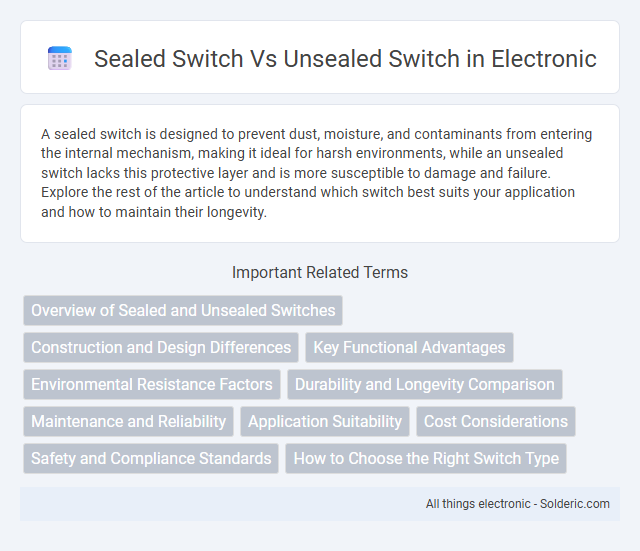A sealed switch is designed to prevent dust, moisture, and contaminants from entering the internal mechanism, making it ideal for harsh environments, while an unsealed switch lacks this protective layer and is more susceptible to damage and failure. Explore the rest of the article to understand which switch best suits your application and how to maintain their longevity.
Comparison Table
| Feature | Sealed Switch | Unsealed Switch |
|---|---|---|
| Protection | Waterproof, dustproof | No protection against elements |
| Durability | High resistance to corrosion and contamination | Prone to corrosion and dirt ingress |
| Applications | Outdoor equipment, industrial machinery | Indoor, dry environments |
| Maintenance | Low due to sealed design | Requires regular cleaning |
| Cost | Higher initial cost | Lower cost |
| Reliability | Consistent performance in harsh conditions | Variable, affected by environment |
Overview of Sealed and Unsealed Switches
Sealed switches feature a protective housing that prevents dust, moisture, and contaminants from entering, enhancing durability and reliability in harsh environments. Unsealed switches lack this protective barrier, making them more susceptible to environmental damage but often more cost-effective for indoor or controlled conditions. Understanding the differences helps you select the appropriate switch type based on your specific application requirements.
Construction and Design Differences
Sealed switches feature an enclosure that protects internal components from dust, moisture, and contaminants, utilizing materials such as rubber or silicone gaskets for airtight sealing. Unsealed switches lack this protective barrier, exposing the contacts and mechanisms directly to the environment, which can lead to increased wear and potential failure in harsh conditions. The construction of sealed switches often includes robust housings and protective membranes, while unsealed switches prioritize simplicity and cost-effectiveness without environmental protection layers.
Key Functional Advantages
A sealed switch offers superior protection against dust, moisture, and contaminants, ensuring reliable operation in harsh environments, while unsealed switches are more susceptible to environmental damage but provide cost-effective solutions for controlled indoor applications. The hermetic sealing in sealed switches extends device lifespan and reduces maintenance needs by preventing ingress that could cause corrosion or short circuits. Unsealed switches typically provide easier installation and replacement but lack the durability and reliability required in industrial or outdoor settings.
Environmental Resistance Factors
Sealed switches offer superior environmental resistance factors such as protection against dust, moisture, and corrosive elements, making them ideal for harsh or outdoor conditions. Unsealed switches lack these protective barriers, increasing vulnerability to contaminants and reducing reliability in challenging environments. Selecting a sealed switch enhances your device's durability and operational lifespan where environmental exposure is a critical concern.
Durability and Longevity Comparison
Sealed switches offer superior durability and longevity due to their protective enclosure that prevents dust, moisture, and contaminants from entering the internal components. Unsealed switches are more susceptible to environmental damage, leading to faster wear and potential failure in harsh conditions. This makes sealed switches ideal for applications requiring extended operational life and reliability in challenging environments.
Maintenance and Reliability
Sealed switches offer superior protection against dust, moisture, and contaminants, significantly reducing maintenance frequency and enhancing long-term reliability in harsh environments. Unsealed switches require more frequent inspections and cleaning due to exposure to external elements that can cause corrosion or interference with electrical contacts. Choosing sealed switches improves system uptime and reduces the risk of failure caused by environmental factors, making them ideal for industrial and outdoor applications.
Application Suitability
Sealed switches are ideal for environments exposed to dust, moisture, or contaminants, making them suitable for outdoor equipment, automotive controls, and industrial machinery. Unsealed switches fit well in clean, dry applications such as consumer electronics or indoor appliances, where exposure to harsh elements is minimal. Choosing the right switch enhances your device's durability and functionality based on the operating environment.
Cost Considerations
Sealed switches generally have higher upfront costs due to their protective casing, which prevents dust, moisture, and contaminants from entering, thus extending their lifespan and reducing maintenance expenses. Unsealed switches offer lower initial investment but may incur more frequent replacements and repairs in harsh environments, increasing total cost of ownership. Your choice should balance immediate budget constraints with long-term durability and reliability needs.
Safety and Compliance Standards
Sealed switches offer enhanced safety by preventing moisture, dust, and contaminants from entering, reducing the risk of electrical shorts and corrosion, which aligns with strict IP (Ingress Protection) and NEMA (National Electrical Manufacturers Association) standards. Unsealed switches expose internal components, making them vulnerable to environmental hazards and typically falling short of rigorous safety certifications required in medical, automotive, and industrial applications. Choosing a sealed switch ensures your device meets critical safety and compliance standards for durability and operational reliability in harsh conditions.
How to Choose the Right Switch Type
Choosing the right switch type depends on the environmental conditions and application requirements. Sealed switches offer protection against dust, moisture, and contaminants, making them ideal for outdoor or industrial use where durability and reliability are critical. Unsealed switches are suitable for controlled, clean environments and provide cost-effective solutions with easier installation and maintenance.
sealed switch vs unsealed switch Infographic

 solderic.com
solderic.com